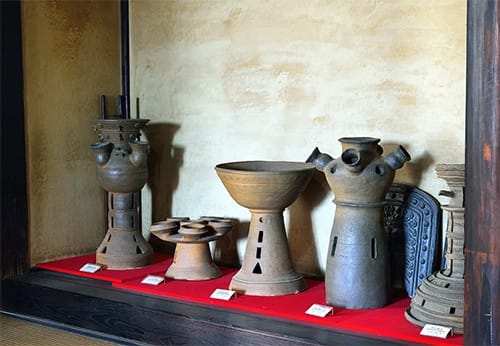


民藝的建築の探訪者、早稲田大学建築科の今和次郎氏の記録に導かれて
この群馬前橋の関根家住宅を深掘り探究してみた。
寄棟型茅葺き屋根の前面部を大胆にカットして生物種としての
カイコの生態に最適適応するように「環境性能」実現に踏み込んだ住宅。
北海道の積雪寒冷条件に対し居住環境性能との格闘を開始した
北海道の家づくりとほぼ同時期にこういう民藝的住宅があった。
このことに深く思いが至っておりました。
民藝とはモノや生活雑器の方に着目されやすいと思うけれど、
各地域でのものづくりの最たるものとしての家づくりで、一棟一棟、
地域の大工たちは知恵と工夫の限りを尽くして施主の要求と格闘してきた。
用をどこまでも追い求めながら、同時に地域製造業の作り手として
評価を高めるように創意工夫と建築の美感を競い合ったのだと思う。
そのプロセスで茅葺き屋根前面部の大胆な切り落としという
独自工法の開発にまで至った。
その真摯な家づくりの姿勢に今和次郎先生は「民藝の真髄」を見出したのだろう。
北海道の家づくり、その環境性能の格闘は孤独な地域努力だったのではなく
はるかな遠雷のように違う目的ながら知恵と工夫で明治初期、
まったく新しい地平を開いていた家づくりを発掘できた思い。
物言わぬカイコから思わぬエールが聞こえてきたようで、楽しくもある(笑)。


そして住宅の手ざわりの部分でのモノの手づくり感。
現代でも「注文住宅」という呼び方で一棟一棟の住宅は
さまざまな創意工夫が込められながら作り出されているのだけれど、
この明治の職人さんたちの家づくり細部ディテールまでの
手づくり感にはまことに圧倒される。
今日の住宅ではキッチンやトイレ、そしてエアコンや暖房機器、換気装置など
大手メーカーの工業生産ラインで作られる設備が
大きな要素を占めているけれど、明治の作り手たちはそれこそ
ダイドコロ火力の火力調節、自在鉤の「小猿」まで専門職人の手づくり。
一定の家内制手工業での量産はあっただろうけれど、
細かい使い勝手の部分や現場での納まりについて責任を持っていた。
家を住みこなす住人とこういう「民具」との共感など、
そこにも民藝的な手ざわり感が感じられてほほえましい。
生活を彩る多くの道具たちも、それぞれが個性的な彩りを放っている。
現代的な世界標準的な合理性をしっかり確保しながら、
しかし一方ではひとびとの日々の暮らしとこころを豊かにさせる
民藝的なあたたかみ、ぬくもりを大切にしていくべきだと思われた。
現代・高断熱高気密の技術をベースに、民藝的発展に期待したい。
私見だけれど、北海道のブロック外断熱住宅など、
素材から断熱手法、打ち放しのような肌ざわりなど、
思わぬ部分で「民藝」要素を強く感じさせられている。<この項、終了>
English version⬇
Universal Lifestyle and Mingei The "Akagi-style" silkworm-farming folk house - 8
Houses are the most local asset. Mingei is difficult to define the concept of "beauty of use," but it is the core of local craftsmanship. Toward the modern Mingei house.
Guided by the records of Mr. Wajiro Kon of Waseda University's Department of Architecture, an explorer of folk-artistic architecture
I did in-depth coverage of this Sekine family residence in Maebashi, Gunma.
The front part of the hipped thatched roof has been boldly cut to optimally adapt to the ecology of the silkworm, a living species.
The front part of the thatched roof is boldly cut to optimally adapt to the ecology of the silkworm, a living organism.
The house was built at about the same time as the houses built in Hokkaido, where the Japanese struggled with the environmental performance for survival in the cold and snowy conditions of Hokkaido.
This kind of folk-art style housing existed at about the same time as Hokkaido's house building.
I was deeply moved by this fact.
Mingei is a term that tends to focus more on objects and daily utensils, but it is also a term that refers to the most important aspects of craftsmanship in each region.
However, in each region, the local carpenters worked hard to create each house one by one, using their wisdom and ingenuity to make the best of their craftsmanship.
Carpenters in each region have been wrestling with the client's demands with the utmost of their wisdom and ingenuity.
While pursuing the best use of their skills and knowledge, the carpenters of the region have also been striving to be the largest manufacturer in the region.
I think they competed with each other to enhance their reputation for originality, ingenuity, and aesthetics.
This process even led to the development of a unique method of boldly cutting off the front part of the thatched roof.
This process even led to the development of a unique construction method, which involved boldly cutting off the front part of the thatched roof.
This sincere approach to house building must have been recognized by Mr. Wajiro Kon as the "essence of folk craftsmanship.
The struggle to build houses in Hokkaido and their environmental performance was not a solitary regional effort.
It was not a solitary local effort, but rather a faraway thunderstorm of wisdom and ingenuity that opened up entirely new horizons in the early Meiji period.
I felt as if I had been shown a completely new horizon of house building in the early Meiji period.
It was as if I heard an unexpected cry from a silent silkworm, and I enjoyed it (laugh).
And the handmade feel of things in the handcrafted part of the house.
Even today, each house is called a "custom-built house.
but the handmade feeling of the details of the house
The sense of handmade in every detail of house construction by craftsmen in the Meiji era is truly overwhelming.
The handmade sense of detail and craftsmanship of these Meiji craftsmen is truly overwhelming.
In today's houses, kitchens, toilets, air conditioners, heating systems, ventilation systems, etc. are all handmade on industrial production lines by major manufacturers.
air conditioners, heating systems, ventilation systems, and other equipment made on industrial production lines by major manufacturers.
but the Meiji makers were not so much concerned with the details as they were with the
The fire control of the "daidokoro" fireplace and even the "kozaru" (small monkey), a free hook, are all handmade by professional craftsmen.
Well, there must have been a certain amount of mass production by cottage industry, but
However, they were responsible for the detailed usability of the house.
The residents who lived in the house and these "folk tools" were in sympathy with each other.
The sense of touch of folk craftsmanship can be felt in the relationship between the residents who live in the houses and these "folk tools.
Many of the tools used to add color to daily life are also unique and colorful in their own way.
While ensuring the rationality of modern global standards
On the other hand, on the other hand, there is a folk art-like warmth that enriches people's daily life and spirit.
and warmth of folk art that enriches people's daily life and spirit.
I look forward to the development of the folk art style based on modern, highly insulated and airtight technology.
In my opinion, the block-insulated houses in Hokkaido, for example, should be built in the same way.
I would like to see the development of folk art style based on modern high thermal insulation and high airtightness technology.
I am strongly impressed by unexpected "folk art" elements.










